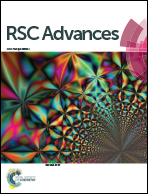Chitosan scaffolds for recyclable adsorption of Cu(ii) ions†
Abstract
Chitosan scaffolds with hierarchical macroporous structures for recyclable adsorption of Cu(II) ions are prepared by templating from Pickering high internal phase emulsions (HIPEs) for the first time. The liquid paraffin-in-water HIPEs are stabilized by chitosan nanoparticles (CNPs). The internal phase fraction can be up to 90.0%; meanwhile, the chitosan concentration only needs to be 1.0 wt%. The chitosan scaffolds were obtained by crosslinking the dispersed CNPs, followed by removing the internal phase. The resulting scaffold exhibits the average pore size of around 15 μm and interconnecting channel size of several micrometers. The adsorption capacities of the chitosan–glutaraldehyde (chitosan–GLA) scaffolds for Cu(II) ions increase with increasing the molar ratio of –NH2 of CNPs to –CHO of GLA. At the optimized ratio of 2 : 1, the adsorption capacity is 60.2 mg g−1 at room temperature and pH 5.0. The adsorption capacity can be greatly improved by addition of carboxymethylated chitosan or adopting an imprinting method, and the adsorption capacities are 100.2 and 90.3 mg g−1, respectively. The adsorption isotherm of the chitosan scaffold closely follows Freundlich model. Furthermore, the adsorption capacity of the scaffold after undergoing 10 consecutive desorption–adsorption cycles still remains at a high level of 90.3%, suggesting the chitosan scaffold is a green and recyclable biosorbent for practical wastewater treatment.


 Please wait while we load your content...
Please wait while we load your content...